A Bibliometric Analysis and Review of Nudge Research Using VOSviewer
Abstract
:1. Introduction
- RQ1: What trend in publication quantities and national and organizational involvement could be identified from nudge research during the period of 2012–2022?
- RQ2: What are the most dominant nudge research disciplines and thematic clusters?
- RQ3: What are the potential areas and future directions of nudge research?
2. Materials and Methods
3. Results and Discussion
3.1. Yearly Publication, Document Type, and Research Categories
3.1.1. Journal Distribution
3.1.2. Country and Institution Distribution
3.1.3. Author Distribution
3.1.4. Keywords Co-Occurrence Analysis
4. Conclusions
Author Contributions
Funding
Institutional Review Board Statement
Informed Consent Statement
Data Availability Statement
Acknowledgments
Conflicts of Interest
References
- Kahan, D.M. Social Influence, Social Meaning, and Deterrence. In Criminal Law; Routledge: London, UK, 2000; ISBN 978-1-315-18943-7. [Google Scholar]
- Thaler, R.H.; Sunstein, C.R. Nudge: Improving Decisions About Health, Wealth, and Happiness; February 24, 2009 Revised Date; Penguin Books: New York, NY, USA, 2009; ISBN 978-0-14-311526-7. [Google Scholar]
- Wu, Y.; Shan, J.; Choguill, C.L. Combining Behavioral Interventions with Market Forces in the Implementation of Land Use Planning in China: A Theoretical Framework Embedded with Nudge. Land Use Policy 2021, 108, 105569. [Google Scholar] [CrossRef]
- Kahneman, D. Thinking, Fast and Slow, 1st ed.; Farrar, Straus and Giroux: New York, NY, USA, 2011; ISBN 978-0-374-53355-7. [Google Scholar]
- Fogg, B.J. Persuasive Technology: Using Computers to Change What We Think and Do. Ubiquity 2002, 2002, 5. [Google Scholar] [CrossRef] [Green Version]
- Fogg, B. A Behavior Model for Persuasive Design. In Proceedings of the 4th International Conference on Persuasive Technology, Claremont CA, USA, 26–29 April 2009; Association for Computing Machinery: New York, NY, USA, 2009; pp. 1–7. [Google Scholar]
- Segerståhl, K.; Oinas-Kukkonen, H. Distributed User Experience in Persuasive Technology Environments. In Proceedings of the Second International Conference on Persuasive Technology (PERSUASIVE 2007), Palo Alto, CA, USA, 26–27 April 2007; pp. 80–91. [Google Scholar]
- Mirsch, T.; Lehrer, C.; Jung, R. Digital Nudging: Altering User Behavior in Digital Environments. In Proceedings of the 13th International Conference on Wirtschaftsinformatik (WI 2017), St. Gallen, Switzerland, 12–15 February 2017. [Google Scholar]
- Blom, S.S.A.H.; Gillebaart, M.; De Boer, F.; van der Laan, N.; De Ridder, D.T.D. Under Pressure: Nudging Increases Healthy Food Choice in a Virtual Reality Supermarket, Irrespective of System 1 Reasoning. Appetite 2021, 160, 105116. [Google Scholar] [CrossRef]
- Kawa, C.; Gijselaers, W.H.; Nijhuis, J.F.H.; Ianiro-Dahm, P.M. Are You “Nudgeable”? Factors Affecting the Acceptance of Healthy Eating Nudges in a Cafeteria Setting. Int. J. Environ. Res. Public Health 2022, 19, 4107. [Google Scholar] [CrossRef]
- Camilleri, A.R.; Cam, M.-A.; Hoffmann, R. Nudges and Signposts: The Effect of Smart Defaults and Pictographic Risk Information on Retirement Saving Investment Choices. J. Behav. Decis. Mak. 2019, 32, 431–449. [Google Scholar] [CrossRef]
- Pilaj, H. The Choice Architecture of Sustainable and Responsible Investment: Nudging Investors Toward Ethical Decision-Making. J Bus. Ethics 2017, 140, 743–753. [Google Scholar] [CrossRef]
- Plak, S.; van Klaveren, C.; Cornelisz, I. Raising Student Engagement Using Digital Nudges Tailored to Students’ Motivation and Perceived Ability Levels. Br. J. Educ. Technol. 2022, 1–27. Available online: https://bera-journals.onlinelibrary.wiley.com/doi/full/10.1111/bjet.13261 (accessed on 15 August 2022). [CrossRef]
- Weijers, R.J.; Ganushchak, L.; Ouwehand, K.; de Koning, B.B. “I’ll Be There”: Improving Online Class Attendance with a Commitment Nudge during COVID-19. Basic Appl. Soc. Psychol. 2022, 44, 12–24. [Google Scholar] [CrossRef]
- Nekmat, E. Nudge Effect of Fact-Check Alerts: Source Influence and Media Skepticism on Sharing of News Misinformation in Social Media. Soc. Med. Soc. 2020, 6, 2056305119897322. [Google Scholar] [CrossRef]
- Pennycook, G.; McPhetres, J.; Zhang, Y.; Lu, J.G.; Rand, D.G. Fighting COVID-19 Misinformation on Social Media: Experimental Evidence for a Scalable Accuracy-Nudge Intervention. Psychol. Sci. 2020, 31, 770–780. [Google Scholar] [CrossRef]
- Wang, X.; Zhang, M.; Fan, W.; Zhao, K. Understanding the Spread of COVID-19 Misinformation on Social Media: The Effects of Topics and a Political Leader’s Nudge. J. Assoc. Inf. Sci. Technol. 2022, 73, 726–737. [Google Scholar] [CrossRef]
- Ghesla, C.; Grieder, M.; Schmitz, J. Nudge for Good? Choice Defaults and Spillover Effects. Front. Psychol. 2019, 10, 178. [Google Scholar] [CrossRef] [Green Version]
- Smith, H.S.; Blumenthal-Barby, J.S.; Chatterjee, R.; Hindera, O.; Huang, A.; Kothari, R.; Vlaev, I. A Review of the MINDSPACE Framework for Nudging Health Promotion During Early Stages of the COVID-19 Pandemic. Popul. Health Manag. 2022, 25, 487–500. [Google Scholar] [CrossRef]
- Tyers, R. Nudging the Jetset to Offset: Voluntary Carbon Offsetting and the Limits to Nudging. J. Sustain. Tour. 2018, 26, 1668–1686. [Google Scholar] [CrossRef]
- Dewies, M.; Schop-Etman, A.; Rohde, K.I.M.; Denktaş, S. Nudging Is Ineffective When Attitudes Are Unsupportive: An Example from a Natural Field Experiment. Basic Appl. Soc. Psychol. 2021, 43, 213–225. [Google Scholar] [CrossRef]
- Sasaki, S.; Kurokawa, H.; Ohtake, F. Effective but Fragile? Responses to Repeated Nudge-Based Messages for Preventing the Spread of COVID-19 Infection. JER 2021, 72, 371–408. [Google Scholar] [CrossRef]
- Hummel, D.; Maedche, A. How Effective Is Nudging? A Quantitative Review on the Effect Sizes and Limits of Empirical Nudging Studies. J. Behav. Exp. Econ. 2019, 80, 47–58. [Google Scholar] [CrossRef]
- Ocean, N.; Woodman, R. When Nudges Backfire: How Not To Improve Attitudes Towards Shared E-Scooters; SSRN: Rochester, NY, USA, 2022. [Google Scholar]
- Clavien, C. Ethics of Nudges: A General Framework with a Focus on Shared Preference Justifications. J. Moral Educ. 2018, 47, 366–382. [Google Scholar] [CrossRef]
- Lembcke, T.-B.; Engelbrecht, N.; Brendel, A.B.; Kolbe, L. To Nudge or Not to Nudge: Ethical Considerations of Digital Nudging Based on Its Behavioral Economics Roots. In Proceedings of the 27th European Conference on Information Systems, Stockholm, Sweden, 8–14 June 2019. [Google Scholar]
- Meske, C.; Amojo, I. Ethical Guidelines for the Construction of Digital Nudges. In Proceedings of the 2020 53rd Hawaii International Conference on System Sciences, Maui, HI, USA, 7–10 January 2020. [Google Scholar]
- Sunstein, C. Nudging and Choice Architecture: Ethical Considerations (January 17, 2015). Yale Journal on Regulation, Forthcoming. Available online: https://ssrn.com/abstract=2551264 (accessed on 15 August 2022).
- Laiou, E.; Rapti, I.; Schwarzer, R.; Fleig, L.; Cianferotti, L.; Ngo, J.; Rizos, E.C.; Wetle, T.F.; Kahlmeier, S.; Vigilanza, A.; et al. Review: Nudge Interventions to Promote Healthy Diets and Physical Activity. Food Policy 2021, 102, 102103. [Google Scholar] [CrossRef]
- Metcalfe, J.J.; Ellison, B.; Hamdi, N.; Richardson, R.; Prescott, M.P. A Systematic Review of School Meal Nudge Interventions to Improve Youth Food Behaviors. Int. J. Behav. Nutr. Phys. Act. 2020, 17, 77. [Google Scholar] [CrossRef]
- Last, B.S.; Buttenheim, A.M.; Timon, C.E.; Mitra, N.; Beidas, R.S. Systematic Review of Clinician-Directed Nudges in Healthcare Contexts. BMJ Open 2021, 11, e048801. [Google Scholar] [CrossRef]
- Ioannou, A.; Tussyadiah, I.; Miller, G.; Li, S.; Weick, M. Privacy nudges for disclosure of personal information: A systematic literature review and meta-analysis. PLoS ONE 2021, 16, e0256822. [Google Scholar] [CrossRef]
- Qu, L.; Chau, P.Y.K. Nudge with Interface Designs of Online Product Review Systems—Effects of Online Product Review System Designs on Purchase Behavior. Inf. Technol. People 2022. ahead-of-print. [Google Scholar] [CrossRef]
- Reñosa, M.D.C.; Landicho, J.; Wachinger, J.; Dalglish, S.L.; Bärnighausen, K.; Bärnighausen, T.; McMahon, S.A. Nudging toward Vaccination: A Systematic Review. BMJ Global Health 2021, 6, e006237. [Google Scholar] [CrossRef]
- Donthu, N.; Kumar, S.; Mukherjee, D.; Pandey, N.; Lim, W.M. How to Conduct a Bibliometric Analysis: An Overview and Guidelines. J. Bus. Res. 2021, 133, 285–296. [Google Scholar] [CrossRef]
- Donthu, N.; Kumar, S.; Pandey, N.; Pandey, N.; Mishra, A. Mapping the Electronic Word-of-Mouth (EWOM) Research: A Systematic Review and Bibliometric Analysis. J. Bus. Res. 2021, 135, 758–773. [Google Scholar] [CrossRef]
- Moral-Muñoz, J.A.; Herrera-Viedma, E.; Santisteban-Espejo, A.; Cobo, M.J. Software Tools for Conducting Bibliometric Analysis in Science: An up-to-Date Review. Prof. Inf. 2020, 29, e290103. [Google Scholar] [CrossRef] [Green Version]
- Castillo-Vergara, M.; Alvarez-Marin, A.; Placencio-Hidalgo, D. A Bibliometric Analysis of Creativity in the Field of Business Economics. J. Bus. Res. 2018, 85, 1–9. [Google Scholar] [CrossRef]
- Xia, Q.; Yan, S.; Li, H.; Duan, K.; Zhang, Y. A Bibliometric Analysis of Knowledge-Hiding Research. Behav. Sci. 2022, 12, 122. [Google Scholar] [CrossRef]
- van Eck, N.J.; Waltman, L. VOSViewer: Visualizing Scientific Landscapes, Version 1; Centre for Science and Technology Studies: Leiden, The Netherlands, 2010.
- Noor, S.; Guo, Y.; Shah, S.H.H.; Nawaz, M.S.; Butt, A.S. Bibliometric Analysis of Social Media as a Platform for Knowledge Management. Int. J. Knowl. Manag. IJKM 2020, 16, 33–51. [Google Scholar] [CrossRef]
- Gizzi, F.T.; Potenza, M.R. The Scientific Landscape of November 23rd, 1980 Irpinia-Basilicata Earthquake: Taking Stock of (Almost) 40 Years of Studies. Geosciences 2020, 10, 482. [Google Scholar] [CrossRef]
- Martinho, V.J.P.D. Agricultural Entrepreneurship in the European Union: Contributions for a Sustainable Development. Appl. Sci. 2020, 10, 2080. [Google Scholar] [CrossRef] [Green Version]
- Hossain, S.; Batcha, M.S.; Atoum, I.; Ahmad, N.; Al-Shehri, A. Bibliometric Analysis of the Scientific Research on Sustainability in the Impact of Social Media on Higher Education during the COVID-19 Pandemic. Sustainability 2022, 14, 16388. [Google Scholar] [CrossRef]
- van Eck, N.J.; Waltman, L. How to Normalize Cooccurrence Data? An Analysis of Some Well-Known Similarity Measures. J. Am. Soc. Inf. Sci. Technol. 2009, 60, 1635–1651. [Google Scholar] [CrossRef] [Green Version]
- Waltman, L.; van Eck, N.J.; Noyons, E.C.M. A Unified Approach to Mapping and Clustering of Bibliometric Networks. J. Informetr. 2010, 4, 629–635. [Google Scholar] [CrossRef] [Green Version]
- Weinmann, M.; Schneider, C.; vom Brocke, J. Digital Nudging. Bus. Inf. Syst. Eng. 2016, 58, 433–436. [Google Scholar] [CrossRef] [Green Version]
- Kong, N.; Heer, J.; Agrawala, M. Perceptual Guidelines for Creating Rectangular Treemaps. IEEE Trans. Vis. Comput. Graph. 2010, 16, 990–998. [Google Scholar] [CrossRef] [Green Version]
- Blumenthal-Barby, J.S.; Burroughs, H. Seeking Better Health Care Outcomes: The Ethics of Using the “Nudge”. Am. J. Bioeth. 2012, 12, 634481. [Google Scholar] [CrossRef]
- Hollands, G.J.; Shemilt, I.; Marteau, T.M.; Jebb, S.A.; Kelly, M.P.; Nakamura, R.; Suhrcke, M.; Ogilvie, D. Altering Micro-Environments to Change Population Health Behaviour: Towards an Evidence Base for Choice Architecture Interventions. BMC Public Health 2013, 13, 1218. [Google Scholar] [CrossRef]
- Arno, A.; Thomas, S. The Efficacy of Nudge Theory Strategies in Influencing Adult Dietary Behaviour: A Systematic Review and Meta-Analysis. BMC Public Health 2016, 16, 676. [Google Scholar] [CrossRef]
- John, P.; Cotterill, S.; Moseley, A.; Richardson, L.; Smith, G.; Stoker, G.; Wales, C. Nudge, Nudge, Think, Think: Experimenting with Ways to Change Citizen Behaviour, 2nd ed.; Manchester University Press: Manchester, UK, 2020; ISBN 978-1-5261-5348-7. [Google Scholar]
- Guo, Y.-M.; Huang, Z.-L.; Guo, J.; Li, H.; Guo, X.-R.; Nkeli, M.J. Bibliometric Analysis on Smart Cities Research. Sustainability 2019, 11, 3606. [Google Scholar] [CrossRef] [Green Version]
- van Eck, N.J.; Waltman, L. Software Survey: VOSviewer, a Computer Program for Bibliometric Mapping. Scientometrics 2010, 84, 523–538. [Google Scholar] [CrossRef] [PubMed] [Green Version]
- National Science and Technology Council. Social and Behavioral Sciences Team: Annual Report; Executive Office of the President: Washington, DC, USA, 2015. [Google Scholar]
- Thaler, R.H. From Cashews to Nudges: The Evolution of Behavioral Economics. Am. Econ. Rev. 2018, 108, 1265–1287. [Google Scholar] [CrossRef] [Green Version]
- Merigó, J.M.; Gil-Lafuente, A.M.; Yager, R.R. An Overview of Fuzzy Research with Bibliometric Indicators. Appl. Soft. Comput. 2015, 27, 420–433. [Google Scholar] [CrossRef]
- Thorndike, A.N.; Riis, J.; Sonnenberg, L.M.; Levy, D.E. Traffic-Light Labels and Choice Architecture: Promoting Healthy Food Choices. Am. J. Prev. Med. 2014, 46, 143–149. [Google Scholar] [CrossRef] [Green Version]
- Nobanee, H.; Al Hamadi, F.Y.; Abdulaziz, F.A.; Abukarsh, L.S.; Alqahtani, A.F.; AlSubaey, S.K.; Alqahtani, S.M.; Almansoori, H.A. A Bibliometric Analysis of Sustainability and Risk Management. Sustainability 2021, 13, 3277. [Google Scholar] [CrossRef]
- Gaviria-Marin, M.; Merigó, J.M.; Baier-Fuentes, H. Knowledge Management: A Global Examination Based on Bibliometric Analysis. Technol. Forecast. Soc. Change 2019, 140, 194–220. [Google Scholar] [CrossRef]
- John, P.; Martin, A.; Mikołajczak, G. Support for Behavioral Nudges versus Alternative Policy Instruments and Their Perceived Fairness and Efficacy. Regul. Gov. 2022, rego.12460. [Google Scholar] [CrossRef]
- Guan, B.; Bao, G.; Liu, Q.; Raymond, R.G. Two-Way Risk Communication, Public Value Consensus, and Citizens’ Policy Compliance Willingness About COVID-19: Multilevel Analysis Based on a Nudge View. Adm. Soc. 2021, 53, 1106–1149. [Google Scholar] [CrossRef]
- Kipper, J. Irresistible Nudges, Inevitable Nudges, and the Freedom to Choose. Moral Philos. Politics 2021, 8, 285–303. [Google Scholar] [CrossRef]
- Raskoff, S.Z. Nudges and Hard Choices. Bioethics 2022, 36, 948–956. [Google Scholar] [CrossRef] [PubMed]
- Houk, T. On Nudging’s Supposed Threat to Rational Decision-Making. J. Med. Philos. Forum Bioeth. Philos. Med. 2019, 44, 403–422. [Google Scholar] [CrossRef] [PubMed]
- Mukerji, N.; Mannino, A. Nudge Me If You Can! Why Order Ethicists Should Embrace the Nudge Approach. J. Bus. Ethics 2022. [Google Scholar] [CrossRef]
- Andı, S.; Akesson, J. Nudging Away False News: Evidence from a Social Norms Experiment. Digit. J. 2021, 9, 106–125. [Google Scholar] [CrossRef]
- Kroll, T.; Stieglitz, S. Digital Nudging and Privacy: Improving Decisions about Self-Disclosure in Social Networks. Behav. Inf. Technol. 2021, 40, 1–19. [Google Scholar] [CrossRef]
- Mirbabaie, M.; Ehnis, C.; Stieglitz, S.; Bunker, D.; Rose, T. Digital Nudging in Social Media Disaster Communication. Inf. Syst. Front. 2021, 23, 1097–1113. [Google Scholar] [CrossRef]
- Thaler, R.H.; Unstein, C.R.S.; Balz, J.P. Choice Architecture; Princeton University Press: Princeton, NJ, USA, 2012. [Google Scholar] [CrossRef]
- Gajewski, J.-F.; Heimann, M.; Meunier, L. Nudges in SRI: The Power of the Default Option. J. Bus. Ethics 2022, 177, 547–566. [Google Scholar] [CrossRef]
- Van Gestel, L.C.; Adriaanse, M.A.; De Ridder, D.T.D. Do Nudges Make Use of Automatic Processing? Unraveling the Effects of a Default Nudge under Type 1 and Type 2 Processing. Compr. Results Soc. Psychol. 2020, 1–21. [Google Scholar] [CrossRef]
- Dur, R.; Fleming, D.; van Garderen, M.; van Lent, M. A Social Norm Nudge to Save More: A Field Experiment at a Retail Bank. J. Public Econ. 2021, 200, 104443. [Google Scholar] [CrossRef]
- Drews, S.; Exadaktylos, F.; van den Bergh, J.C.J.M. Assessing Synergy of Incentives and Nudges in the Energy Policy Mix. Energy Policy 2020, 144, 111605. [Google Scholar] [CrossRef]
- Crago, C.L.; Spraggon, J.M.; Hunter, E. Motivating Non-Ratepaying Households with Feedback and Social Nudges: A Cautionary Tale. Energy Policy 2020, 145, 111764. [Google Scholar] [CrossRef]
- Abellán-Perpiñán, J.M.; Cierco Seira, C.; Jimenez-Gomez, D. Nudges y la pandemia: Un análisis desde la economía y el derecho conductual. Informe SESPAS 2022. Gac. Sanit. 2022, 36, S93–S96. [Google Scholar] [CrossRef] [PubMed]
- Schneider, C.; Weinmann, M.; vom Brocke, J. Digital Nudging: Guiding Online User Choices through Interface Design. Commun. ACM 2018, 61, 67–73. [Google Scholar] [CrossRef]
- Piao, S.; Joo, J. A Behavioral Strategy to Nudge Young Adults to Adopt In-Person Counseling: Gamification. Behav. Sci. 2022, 12, 40. [Google Scholar] [CrossRef] [PubMed]
- Cadario, R.; Chandon, P. Viewpoint: Effectiveness or Consumer Acceptance? Tradeoffs in Selecting Healthy Eating Nudges. Food Policy 2019, 85, 1–6. [Google Scholar] [CrossRef]
- Cadario, R.; Chandon, P. Which Healthy Eating Nudges Work Best? A Meta-Analysis of Field Experiments. Mark. Sci. 2020, 39, 465–486. [Google Scholar] [CrossRef]
- Bauer, J.M.; Bietz, S.; Rauber, J.; Reisch, L.A. Nudging Healthier Food Choices in a Cafeteria Setting: A Sequential Multi-Intervention Field Study. Appetite 2021, 160, 105106. [Google Scholar] [CrossRef]
- Yan, H.; Yates, J.F. Improving Acceptability of Nudges: Learning from Attitudes towards Opt-in and Opt-out Policies. Judgm. Decis. Mak. 2019, 14, 26–39. [Google Scholar] [CrossRef]
- Rauprich, O.; Möllenkamp, M.; Reimann, J.; Huster, S.; Schreyögg, J.; Marckmann, G. Wirksamkeit und ethische Bewertung von Nudging-Interventionen zur Förderung des Selbstmanagements bei Diabetes Mellitus Typ 2. Gesundheitswesen 2022, 84, 1059–1066. [Google Scholar] [CrossRef]
- Waughtal, J.; Luong, P.; Sandy, L.; Chavez, C.; Ho, P.M.; Bull, S. Nudge Me: Tailoring Text Messages for Prescription Adherence through N-of-1 Interviews. Transl. Behav. Med. 2021, 11, 1832–1838. [Google Scholar] [CrossRef]
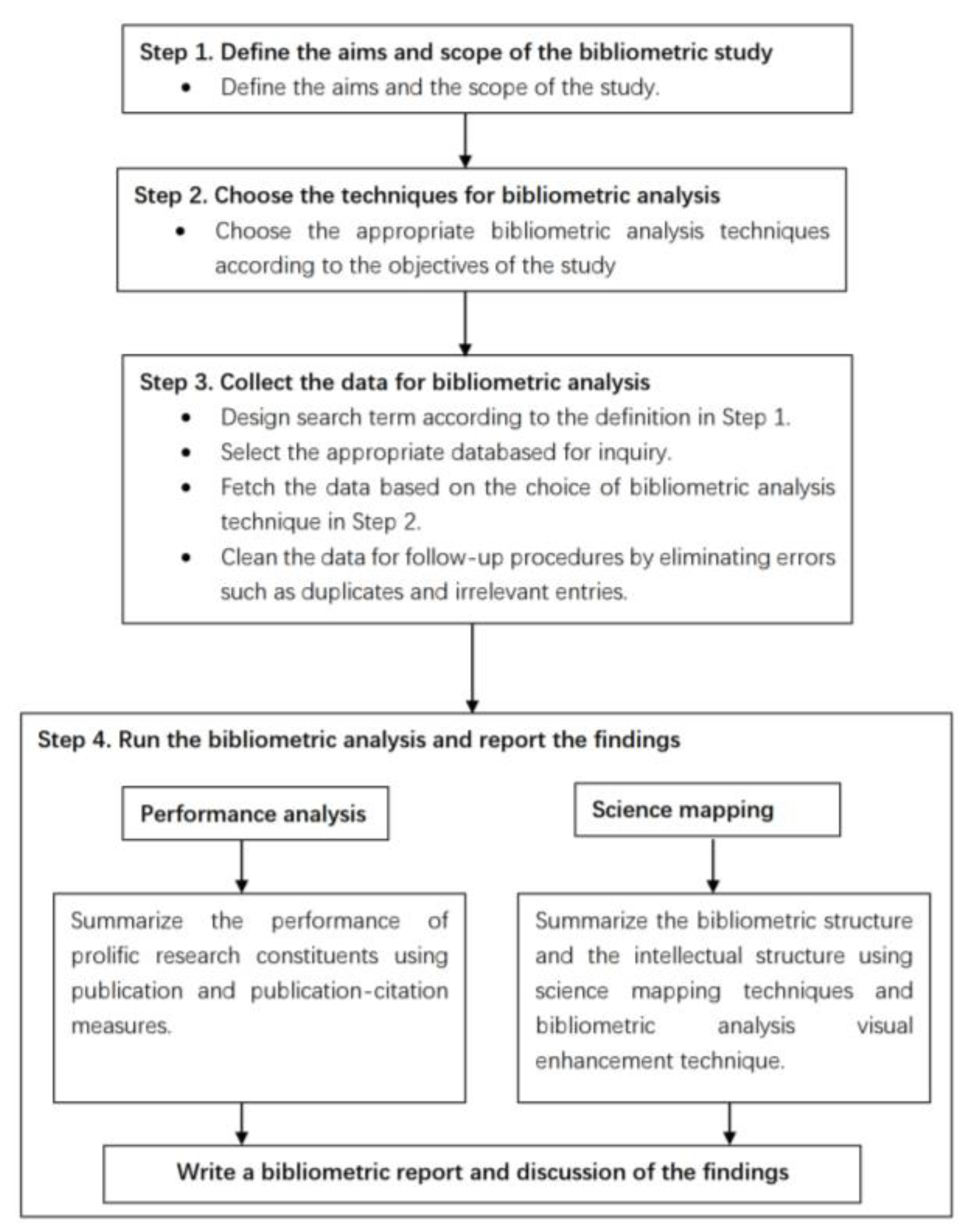
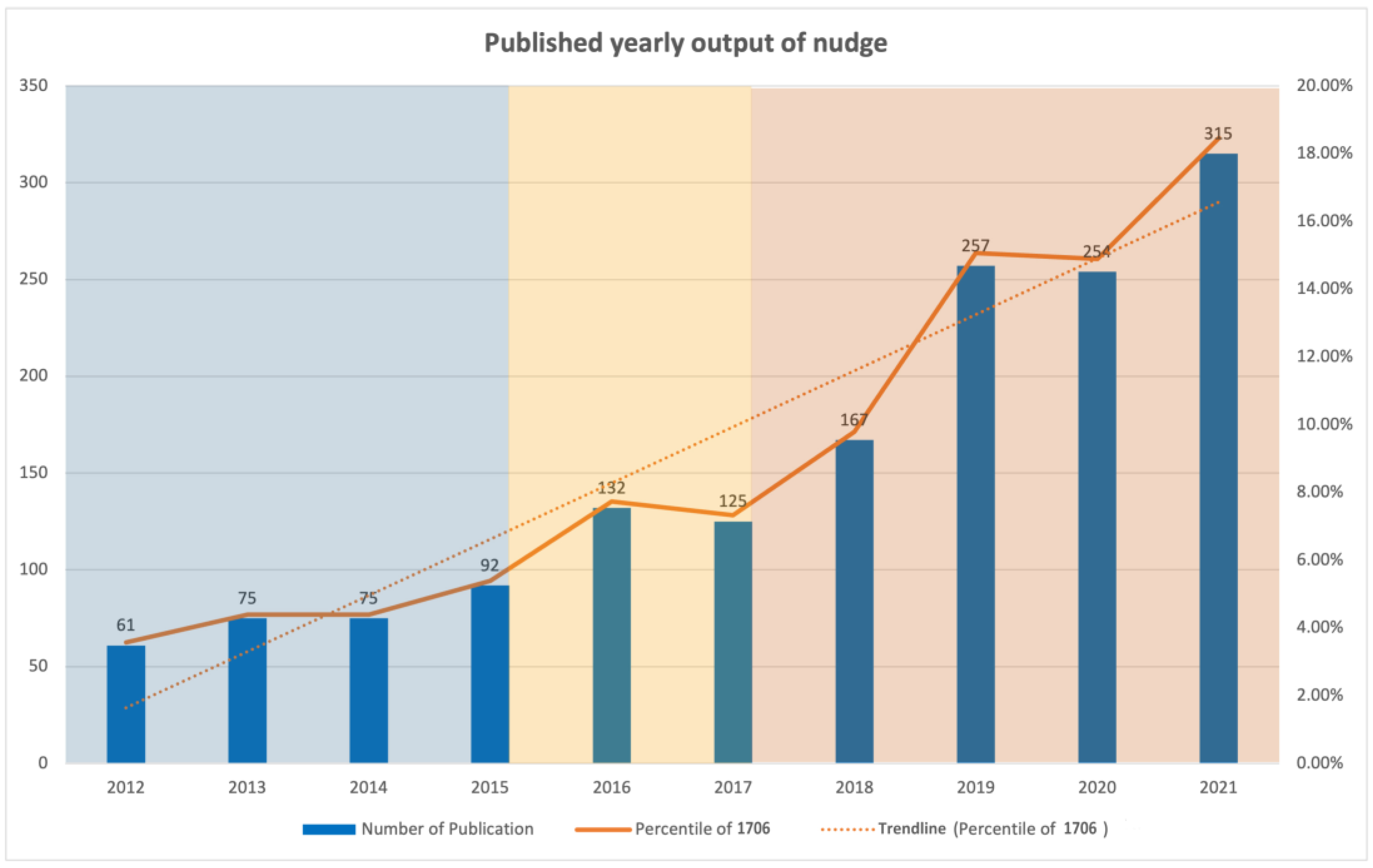
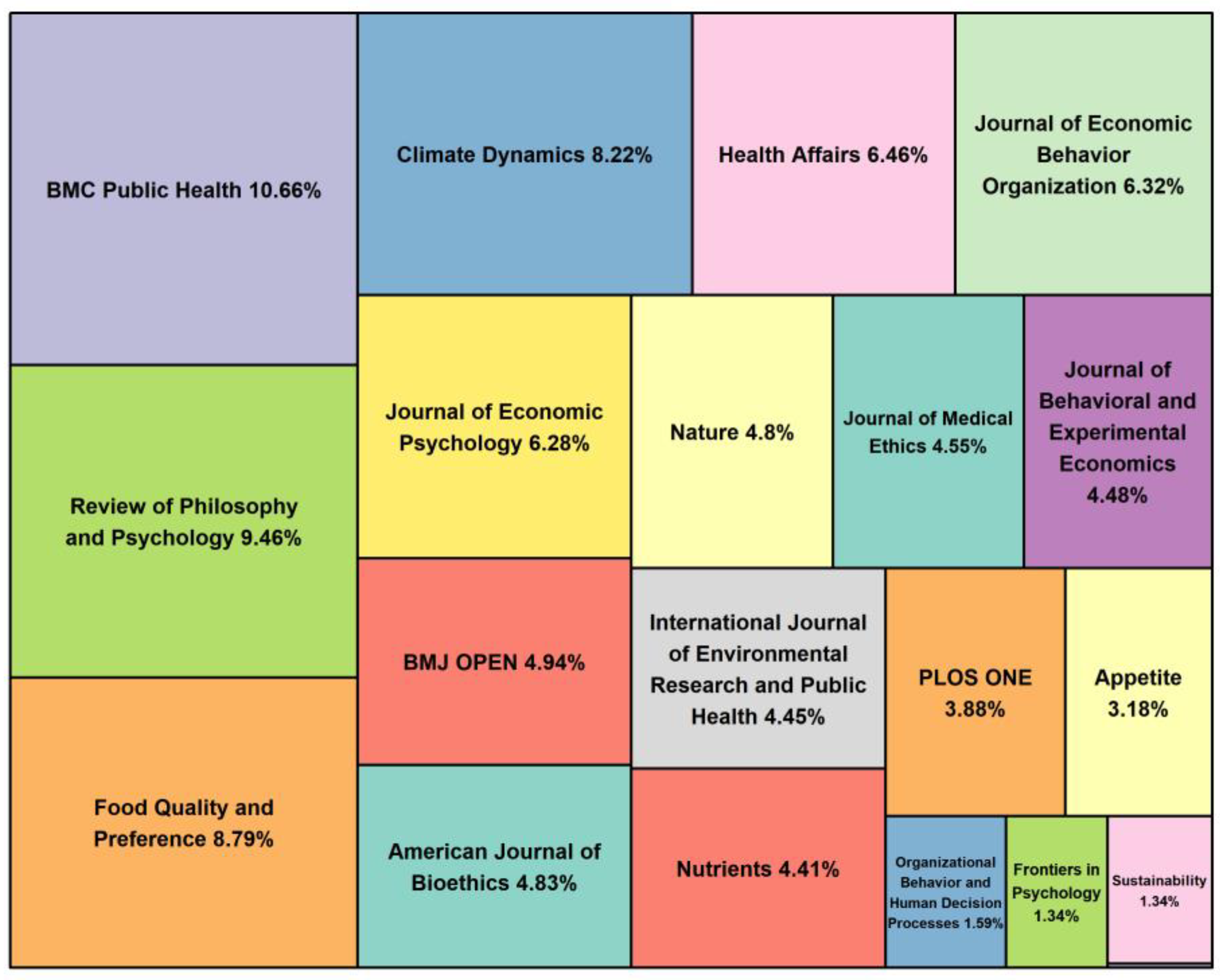
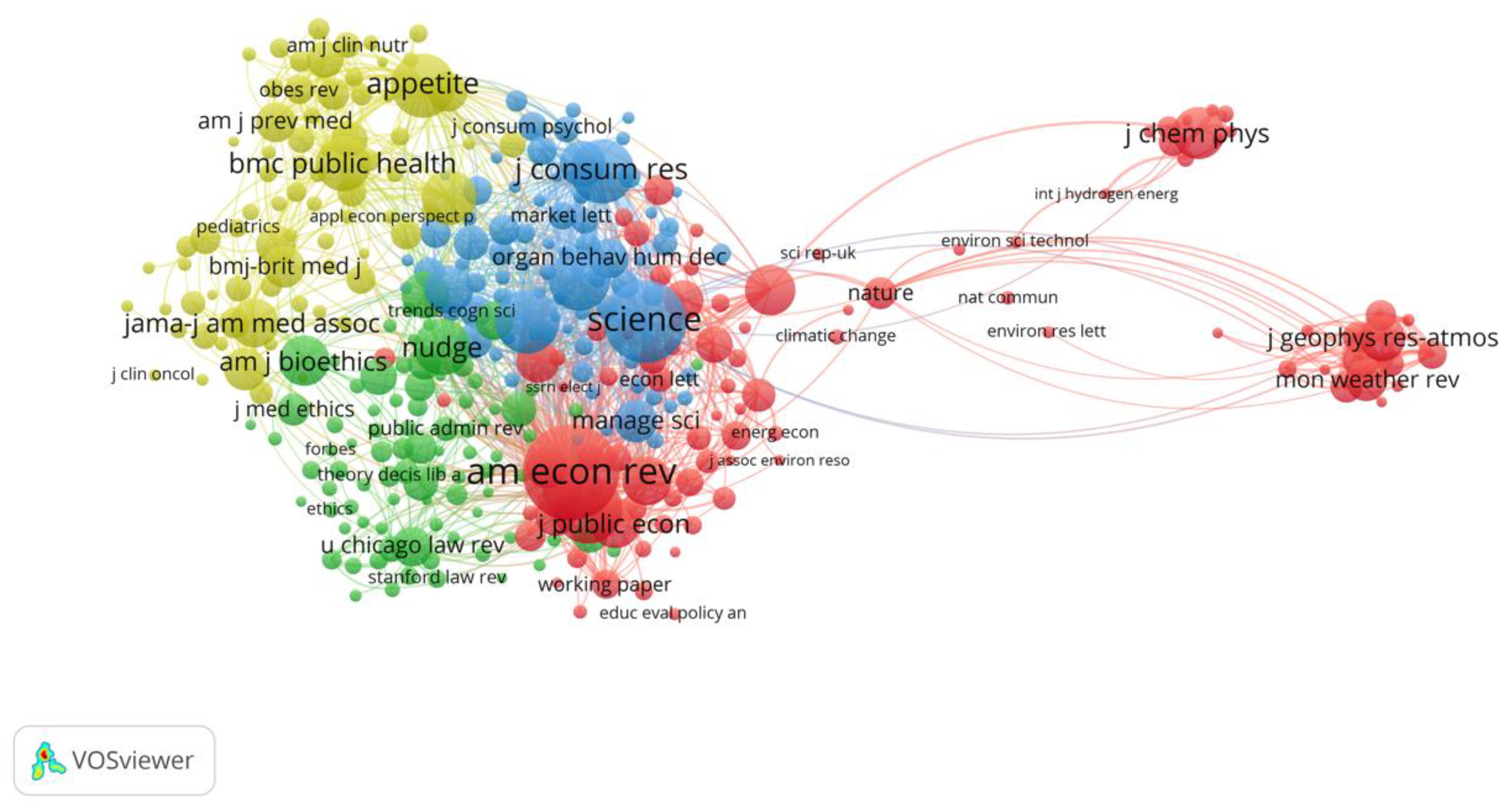
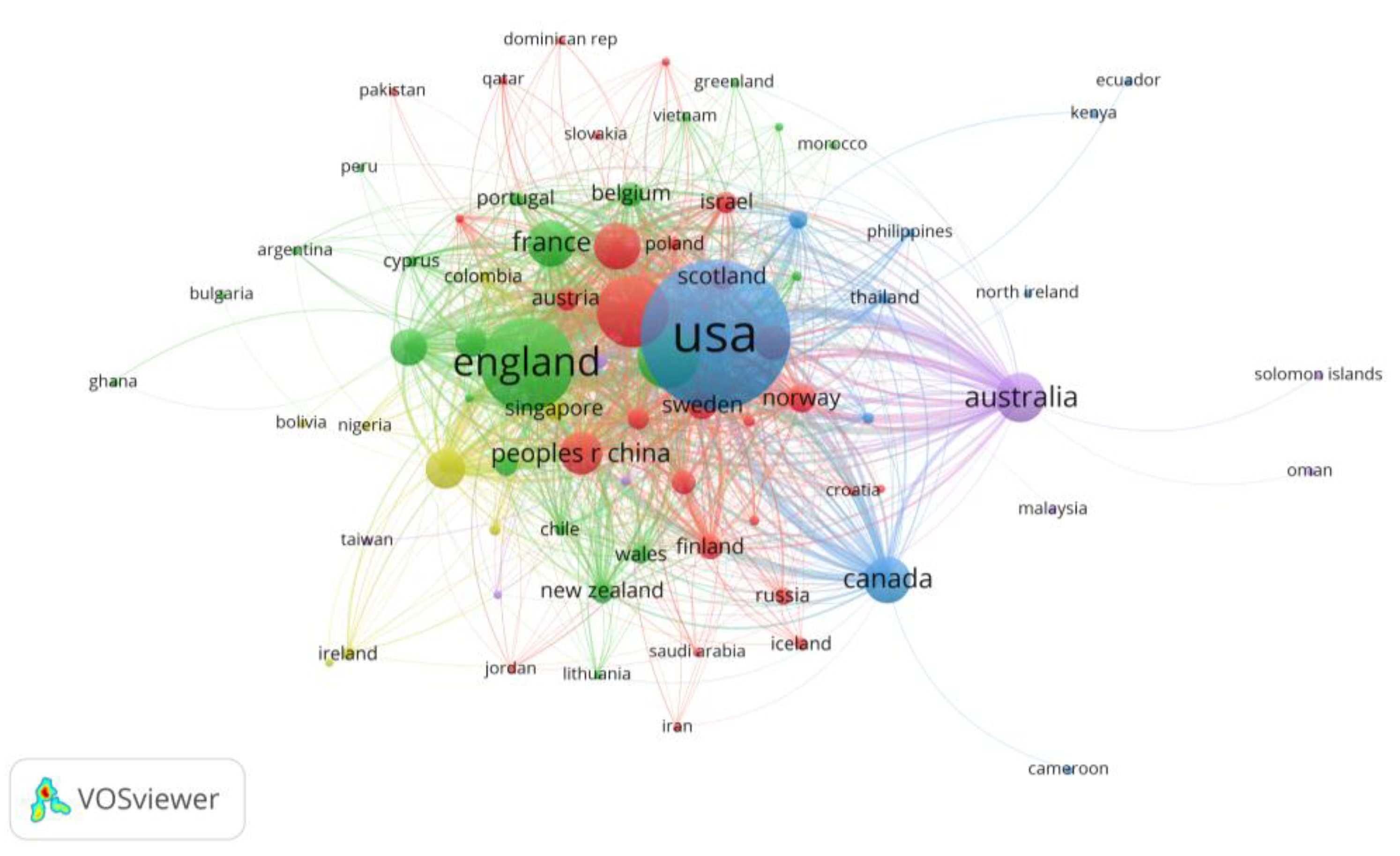
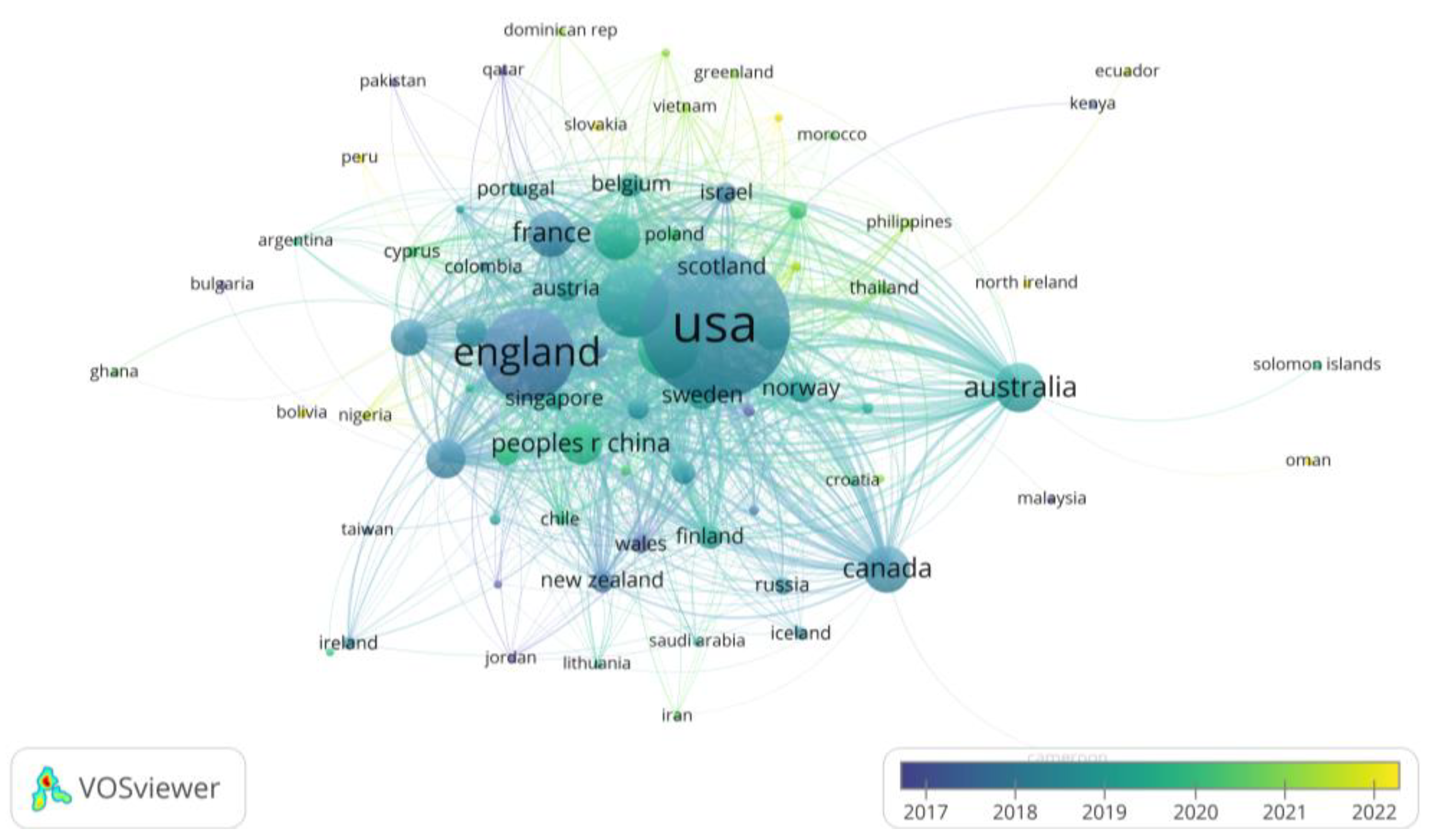
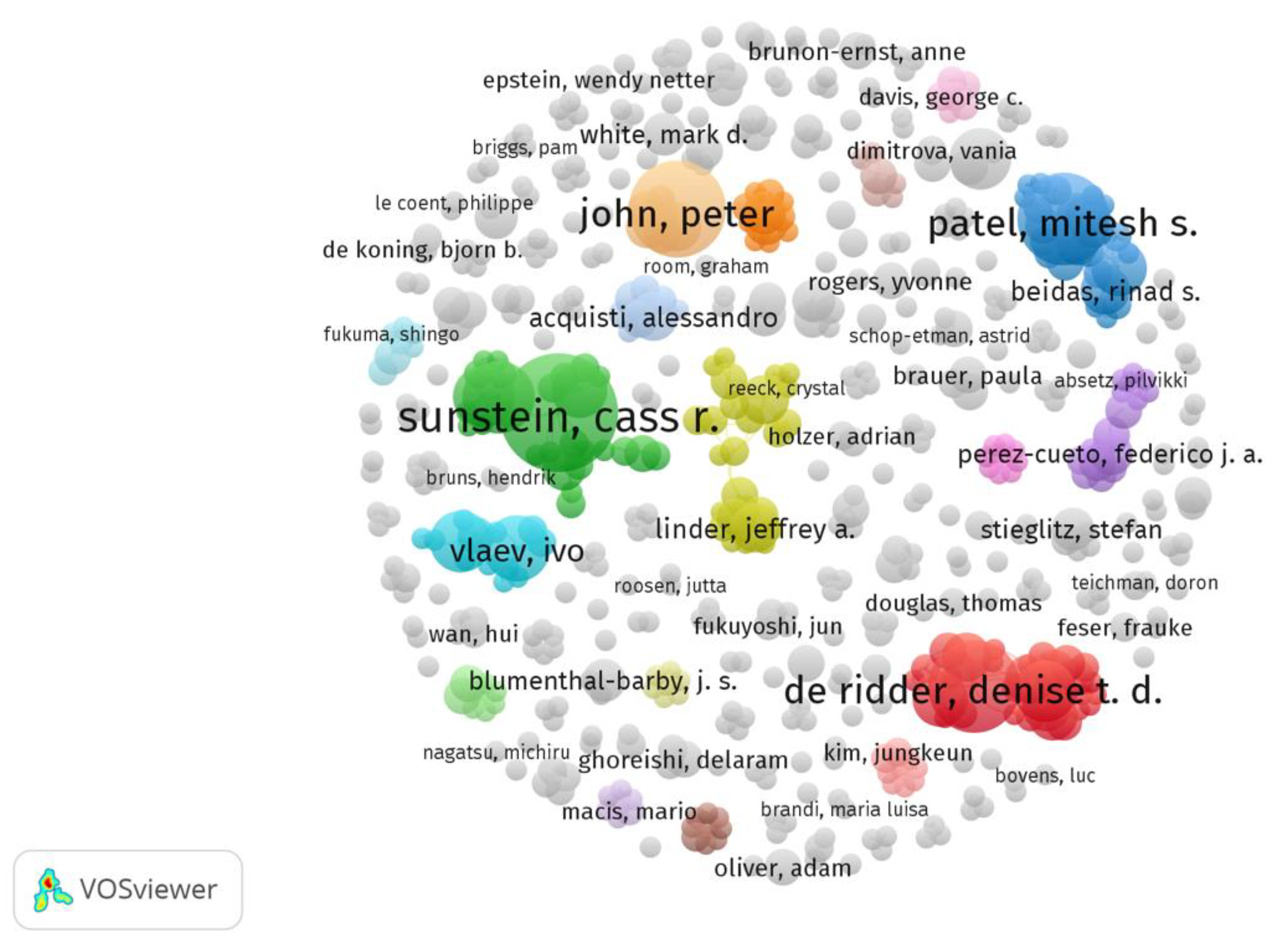
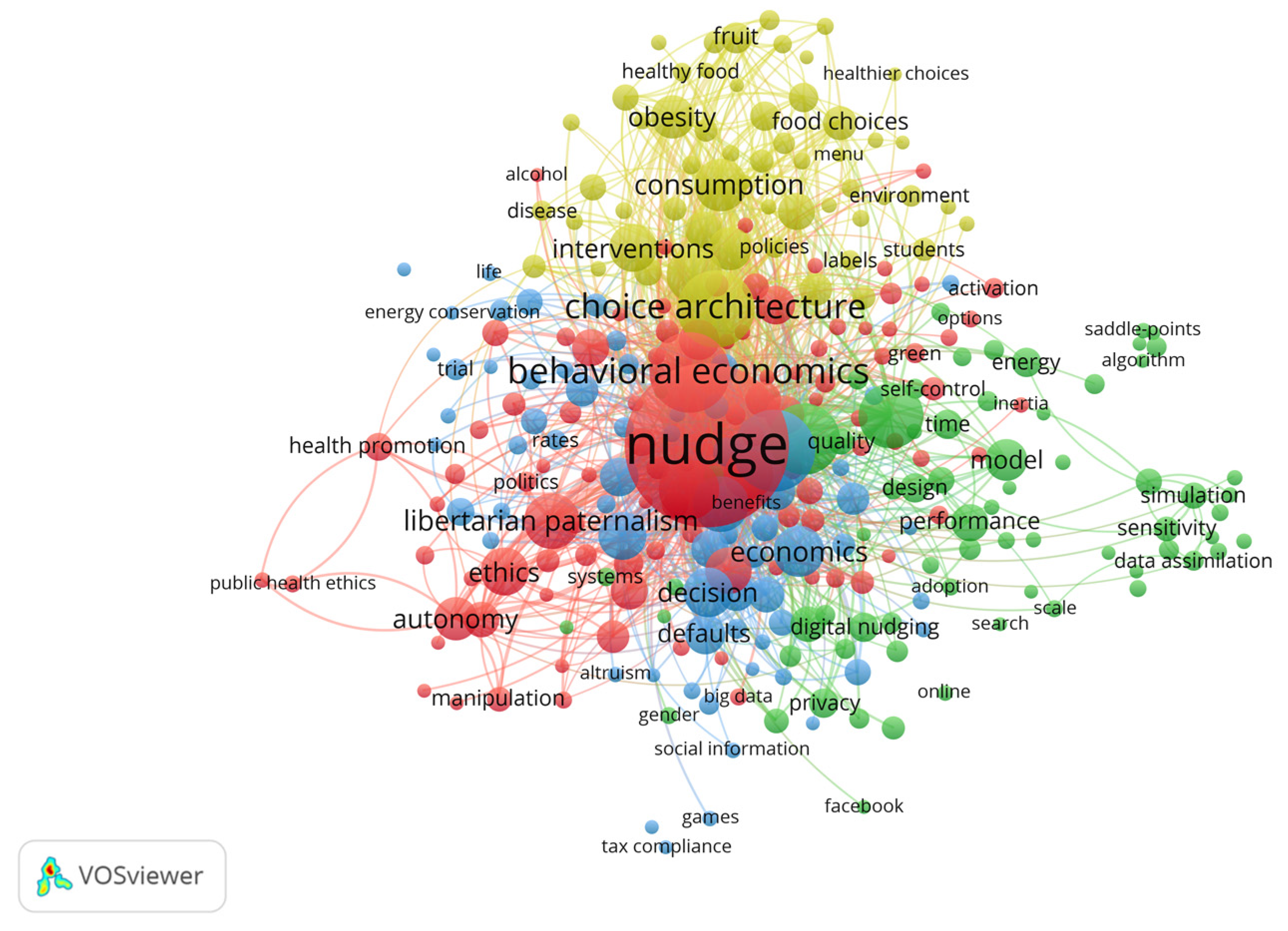
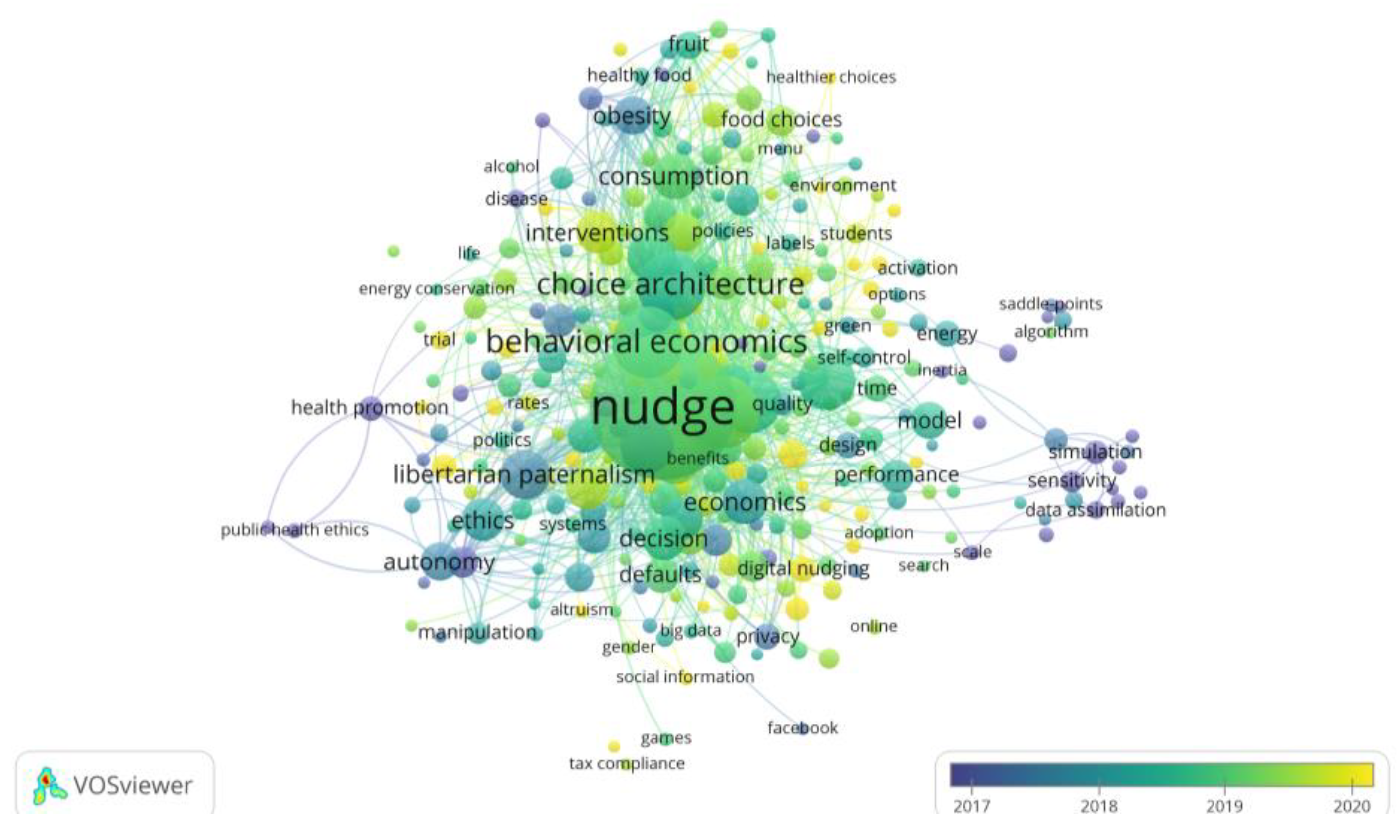
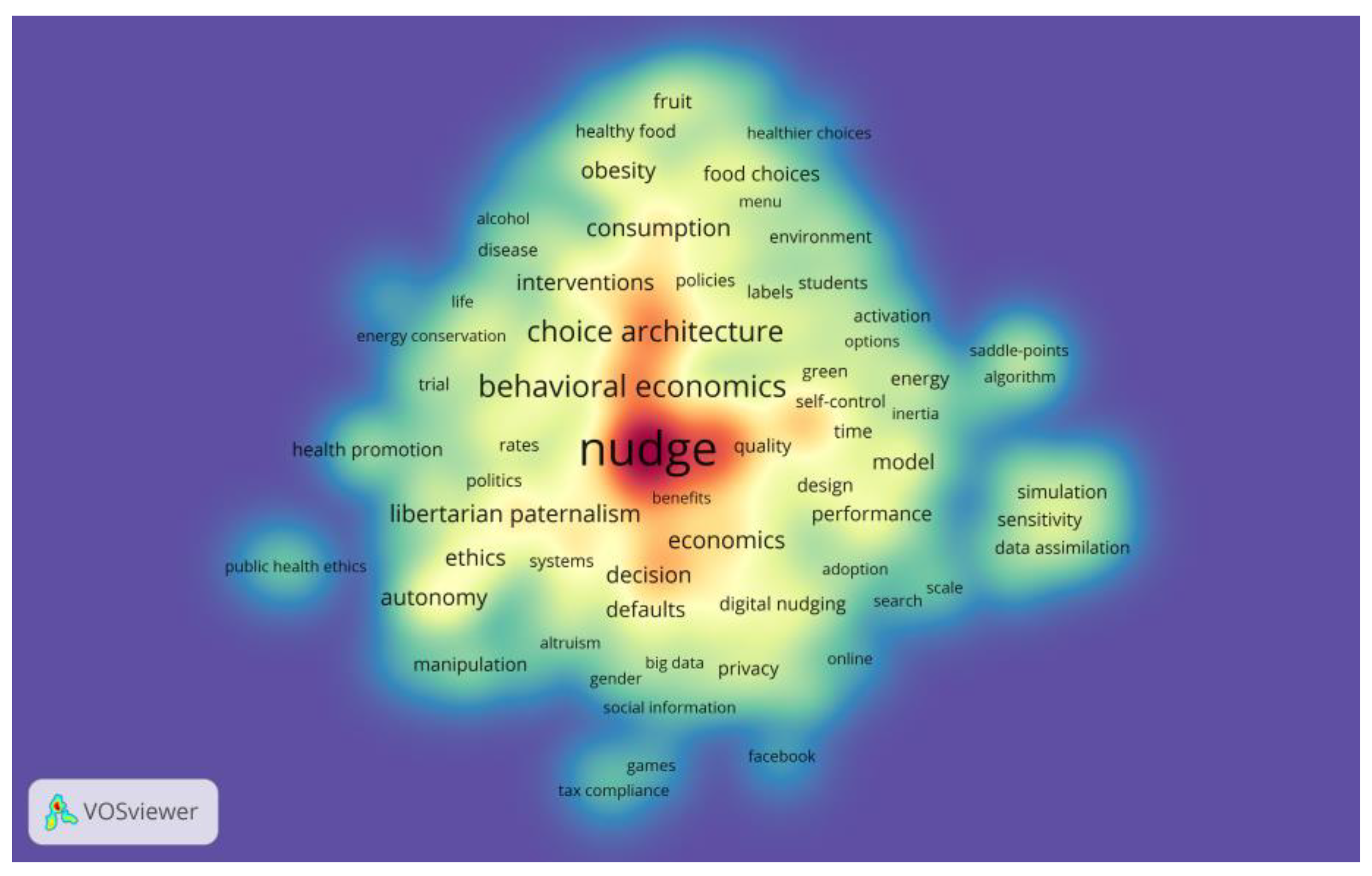
| Type of Publication | Number of Publications | Percentage of Total Publications (%) |
|---|---|---|
| Article | 1217 | 71.34% |
| Editorial Material | 145 | 8.50% |
| Conference Paper | 128 | 7.50% |
| Review | 65 | 3.81% |
| Others | 151 | 8.85% |
| Total | 1706 | 100% |
| Web of Science Categories | Number of Publications | Percentage of Total Publications (%) |
|---|---|---|
| Economics | 226 | 13.25% |
| Public Environmental Occupational Health | 116 | 6.80% |
| Ethics | 102 | 5.98% |
| Psychology Multidisciplinary | 94 | 5.51% |
| Political Science | 78 | 4.57% |
| Public Administration | 77 | 4.51% |
| Law | 74 | 4.34% |
| Social Sciences Biomedical | 72 | 4.22% |
| Multidisciplinary Sciences | 70 | 4.10% |
| Business | 69 | 4.05% |
| Environmental Sciences | 69 | 4.05% |
| Nutrition Dietetics | 69 | 4.05% |
| Computer Science Theory Methods | 67 | 3.93% |
| Health Care Sciences Services | 67 | 3.93% |
| Environmental Studies | 65 | 3.81% |
| Social Issues | 65 | 3.81% |
| Medical Ethics | 63 | 3.69% |
| Management | 60 | 3.52% |
| Computer Science Information Systems | 59 | 3.46% |
| Meteorology Atmospheric Sciences | 52 | 3.05% |
| Journal | Publications | Citation | AC | Index | IF |
|---|---|---|---|---|---|
| American Journal of Bioethics | 33 | 453 | 13.7 | SSCI/SCIE | 14.676 |
| PLOS ONE | 21 | 237 | 11 | SCIE | 3.752 |
| Appetite | 20 | 180 | 9 | SCIE | 5.016 |
| Frontiers in Psychology | 20 | 76 | 3.8 | SSCI | 4.232 |
| Journal of Medical Ethics | 17 | 220 | 12.9 | SSCI/SCIE | 5.926 |
| BMC Public Health | 16 | 483 | 30.2 | SCIE | 4.135 |
| Journal of Economic Behavior Organization | 15 | 269 | 17.9 | SSCI | 2 |
| New Scientist | 14 | 2 | 0.1 | SCIE | 0.319 |
| Food Quality and Preference | 13 | 324 | 24.9 | SCIE | 6.345 |
| Organizational Behavior and Human Decision Processes | 12 | 54 | 4.5 | SSCI | 5.606 |
| Sustainability | 11 | 42 | 3.8 | SSCI/SCI | 3.889 |
| Review of Philosophy and Psychology | 11 | 295 | 26.8 | ESCI | 1.337 |
| Journal of Behavioral and Experimental Economics | 10 | 127 | 12.7 | SSCI | 1.831 |
| BMJ OPEN | 9 | 126 | 14 | SCIE | 3.006 |
| Nature | 9 | 122 | 13.6 | SCIE | 69.504 |
| Climate Dynamics | 8 | 186 | 23.3 | SCIE | 4.901 |
| Health Affairs | 8 | 146 | 18.3 | SSCI/SCIE | 6.301 |
| International Journal of Environmental Research and Public Health | 8 | 101 | 12.6 | SSCI/SCIE | 4.614 |
| Journal of Economic Psychology | 8 | 142 | 17.8 | SSCI | 3 |
| Nutrients | 8 | 100 | 12.5 | SCIE | 6.706 |
| Country | Publications | Citations | Link Strength |
|---|---|---|---|
| USA | 631 | 10,730 | 2813 |
| England | 260 | 3418 | 1670 |
| Germany | 159 | 1986 | 1648 |
| The Netherlands | 116 | 1431 | 1350 |
| Denmark | 54 | 1433 | 1116 |
| Australia | 79 | 867 | 693 |
| Italy | 71 | 511 | 601 |
| Sweden | 32 | 865 | 549 |
| Canada | 73 | 1377 | 545 |
| France | 73 | 915 | 541 |
| Author | Documents | Citations | H-Index |
|---|---|---|---|
| Cass R. Sunstein | 20 | 1057 | 84 |
| Peter John | 15 | 23 | 66 |
| Mitesh S. Patel | 14 | 197 | 34 |
| Denise de Ridder | 14 | 257 | 49 |
| Anne Thorndike | 10 | 465 | 30 |
| Ivo Vlaev | 9 | 105 | 24 |
| Douglas Levy | 8 | 445 | 27 |
| Bart Engelen | 8 | 127 | 9 |
| Magda Osman | 8 | 74 | 19 |
| Joline Beulens | 8 | 58 | 62 |
Disclaimer/Publisher’s Note: The statements, opinions and data contained in all publications are solely those of the individual author(s) and contributor(s) and not of MDPI and/or the editor(s). MDPI and/or the editor(s) disclaim responsibility for any injury to people or property resulting from any ideas, methods, instructions or products referred to in the content. |
© 2022 by the authors. Licensee MDPI, Basel, Switzerland. This article is an open access article distributed under the terms and conditions of the Creative Commons Attribution (CC BY) license (https://creativecommons.org/licenses/by/4.0/).
Share and Cite
Jia, C.; Mustafa, H. A Bibliometric Analysis and Review of Nudge Research Using VOSviewer. Behav. Sci. 2023, 13, 19. https://doi.org/10.3390/bs13010019
Jia C, Mustafa H. A Bibliometric Analysis and Review of Nudge Research Using VOSviewer. Behavioral Sciences. 2023; 13(1):19. https://doi.org/10.3390/bs13010019
Chicago/Turabian StyleJia, Chenjin, and Hasrina Mustafa. 2023. "A Bibliometric Analysis and Review of Nudge Research Using VOSviewer" Behavioral Sciences 13, no. 1: 19. https://doi.org/10.3390/bs13010019
APA StyleJia, C., & Mustafa, H. (2023). A Bibliometric Analysis and Review of Nudge Research Using VOSviewer. Behavioral Sciences, 13(1), 19. https://doi.org/10.3390/bs13010019





